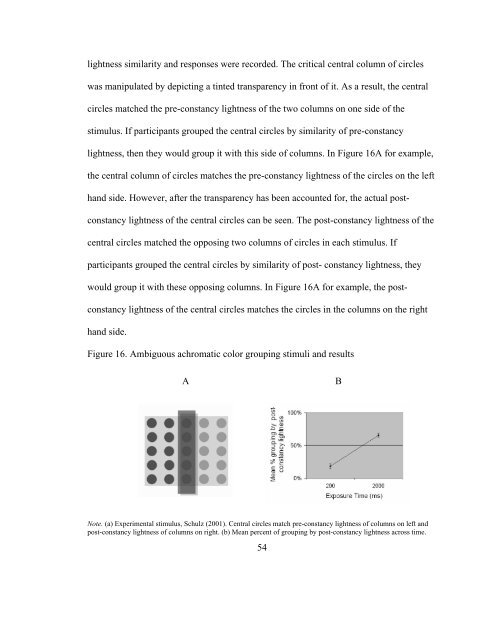The Use of Iambic Pentameter in the
The Use of Iambic Pentameter in the
The Use of Iambic Pentameter in the
You also want an ePaper? Increase the reach of your titles
YUMPU automatically turns print PDFs into web optimized ePapers that Google loves.
lightness similarity and responses were recorded. <strong>The</strong> critical central column <strong>of</strong> circles<br />
was manipulated by depict<strong>in</strong>g a t<strong>in</strong>ted transparency <strong>in</strong> front <strong>of</strong> it. As a result, <strong>the</strong> central<br />
circles matched <strong>the</strong> pre-constancy lightness <strong>of</strong> <strong>the</strong> two columns on one side <strong>of</strong> <strong>the</strong><br />
stimulus. If participants grouped <strong>the</strong> central circles by similarity <strong>of</strong> pre-constancy<br />
lightness, <strong>the</strong>n <strong>the</strong>y would group it with this side <strong>of</strong> columns. In Figure 16A for example,<br />
<strong>the</strong> central column <strong>of</strong> circles matches <strong>the</strong> pre-constancy lightness <strong>of</strong> <strong>the</strong> circles on <strong>the</strong> left<br />
hand side. However, after <strong>the</strong> transparency has been accounted for, <strong>the</strong> actual post-<br />
constancy lightness <strong>of</strong> <strong>the</strong> central circles can be seen. <strong>The</strong> post-constancy lightness <strong>of</strong> <strong>the</strong><br />
central circles matched <strong>the</strong> oppos<strong>in</strong>g two columns <strong>of</strong> circles <strong>in</strong> each stimulus. If<br />
participants grouped <strong>the</strong> central circles by similarity <strong>of</strong> post- constancy lightness, <strong>the</strong>y<br />
would group it with <strong>the</strong>se oppos<strong>in</strong>g columns. In Figure 16A for example, <strong>the</strong> post-<br />
constancy lightness <strong>of</strong> <strong>the</strong> central circles matches <strong>the</strong> circles <strong>in</strong> <strong>the</strong> columns on <strong>the</strong> right<br />
hand side.<br />
Figure 16. Ambiguous achromatic color group<strong>in</strong>g stimuli and results<br />
A<br />
Note. (a) Experimental stimulus, Schulz (2001). Central circles match pre-constancy lightness <strong>of</strong> columns on left and<br />
post-constancy lightness <strong>of</strong> columns on right. (b) Mean percent <strong>of</strong> group<strong>in</strong>g by post-constancy lightness across time.<br />
54<br />
B

















